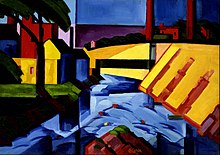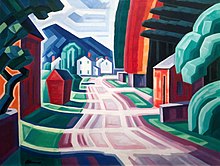Oscar Florianus Bluemner
Oscar Bluemner | |
|---|---|
South Braintree, Massachusetts | |
| Education | Royal Academy of Design, Berlin |
| Known for | Painting, architecture |
| Notable work | Bronx Borough Courthouse |
Oscar Bluemner (June 21, 1867 – January 12, 1938), born Friedrich Julius Oskar Blümner
Early life
Bluemner was born as Friedrich Julius Oskar Blümner in Prenzlau, Kingdom of Prussia (now Germany), on June 21, 1867.[1] He studied painting and architecture at the Royal School of Art in Berlin.[3][4]
Architecture
Bluemner moved to
Painting




In 1908 Bluemner met Alfred Stieglitz, who introduced him to the artistic innovations of the European and American avant-garde. By 1910, Bluemner had decided to pursue painting full-time rather than architecture.
He exhibited in the 1913
He created paintings for the
Later life
After his wife's death in 1926, Bluemner moved to
America sells its shoes, machines, canned beef and so forth in Europe and all over the world not because they have an American style or are wrapped in the American flag, but simply because they are best. Thus also, the French export their paintings and birth-control, and the Germans export sauerkraut and prima donnas, because those things, each, are best. Today, for quality, nationalism, as a race-attribute, means nothing; chemistry, astronomy, or engineering admit, nowhere, of any national flavoring, nor do higher things like religion or philosophy.
Let us, here, make progressive and best painting, each one as he is fit to do, and merely ask: What and when is painting, in a critical sense? ... How can the people agree on what is American style, if the painters themselves, and by their work, disagree profoundly as to what real painting itself is! And there is, and always was, nothing more contemptible, ridiculous and, to art, disastrous, than patrioteering, which thinly veils profiteering.
Ideally, art, pure, is of a sphere and of no country; the first real artists, always and everywhere, have either been importers or immigrants bringing the light with them. El Greco, an immigrant ... defied the Spanish professors ... ; we, now, call his work more truly Spanish than that of his local contemporaries. And in the same sense, the future will not fail to stamp that of our own work as peculiarly American in which the living painter, here, has injected no conscious thought of his hailing from Hoboken or Kankakee, and every consideration of pure and modern painting and of the supreme quality he maybe capable of.
He had a successful one-man show in 1935 at the
He is very much alive and has been working of late ... with robustious [sic] results. These twenty-eight canvases bear the generic title , "New Landscape Paintings." That is because Mr. Blkuemner feels that some degree of "representation" is essential if abstract ideas are to be put over with entire success. However, the artist more fully and more exactly classifies them as "compositions for color themes." He might, if he chose, even call them "color music" without risking the opprobrium that usually attends excursions into so hazardous a field. ... These startling pictures build harmonies and rhythms that depend as a rule on simple statement. Here we find none of the overtones and undertones that some other artists have employed in projecting visual music. Bluemner relies for his effect upon plain, resonant chords. Though modulations of tone occur, these seem of secondary importance in his scheme. There is decidedly something in this new, bold, exclamatory style.
Bluemner died by suicide on January 12, 1938.[10]
Legacy
Stetson University holds more than 1,000 pieces of Oscar Bluemner's work bequeathed in 1997 by his daughter, Vera Bluemner Kouba. In 2009 the Homer and Dolly Hand Art Center at Stetson opened with a primary mission of housing a providing exhibition space for the Kouba Collection.[11] Often overlooked in his lifetime, Bluemner now is widely acknowledged as a key player in the creation of American artistic Modernism, with better-known colleagues such as Georgia O'Keeffe and John Marin.[citation needed]
In 2013, the
An oil painting by Bluemner, Illusion of a Prairie, New Jersey (Red Farm at Pochuck) (1915) sold at Christie's, New York, for $5,346,500 on November 30, 2011.
Artworks
| Year | Title | Image | Collection | Comments |
|---|---|---|---|---|
| 1927 | Loving Moon, watercolor, possibly with a surface coating | Brooklyn Museum, Brooklyn, New York City, New York | [14] | |
| 1932 | Imagination, casein with ground watercolors (prepared by the artist) on paper board | view | Corcoran Gallery of Art, Washington, D.C. | IAP 08260662 |
Notes
- ^ a b Haskell 2005, p. 11
- ^ Haskell 2005, p. 204
- ^ ISBN 9780300196153.
- ^ Bluemner was born as Friedrich Julius Oskar Blümner in Prenzlau, Germany, on June 21, 1867. He studied painting and architecture at the Royal Academy of Design in Berlin.
- ^ a b Corley, Erin (1960). A Finding Aid to the Oscar Bluemner Papers, 1886-1939. Archives of American Art.
- ^ "Landmarks Preservation Commission June 22, 2010, Designation List 430 LP-2388" (PDF). Archived from the original (PDF) on March 26, 2013. Retrieved April 30, 2012.
- ^ Panero, James (February 25, 2013). "The Forgotten Americans". Wall Street Journal. Retrieved February 16, 2015.
- ^ Bluemner, Oscar (January 31, 1932). "What is American Art?" (PDF). New York Times. Retrieved February 16, 2015.
- ^ Jewell, Edward Alden (January 6, 1935). "Holiday Lull Ends in New Activities" (PDF). New York Times. Retrieved February 16, 2015.
- ^ "O.J. Bluemner a Suicide" (PDF). New York Times. January 13, 1938. Retrieved February 16, 2015.
- ^ "The Vera Bluemner Kouba Collection". Stetson University.
- ^ Johnson, Ken (April 25, 2013). "Interrupted Awakening for American Works". New York Times. Retrieved February 16, 2015.
- ^ Zeaman, John (February 17, 2013). "'Oscar Bluemner's America: Picturing Paterson, New Jersey' at the Montclair Art Museum". Bergen Record. Retrieved February 16, 2015.
- ^ "Loving Moon". Brooklyn Museum. Retrieved 2022-10-26.
References
- OCLC 61130814.
Further reading
- OCLC 3255571. Exhibit catalog.
- Hayes, Jeffrey Russell (1991). Oscar Bluemner. Cambridge: Cambridge University Press. OCLC 22314284. Monograph about Bluemner.
- Tonelli, Edith A. (1990). "The Avant-Garde in Boston: The Experiment of the WPA Federal Art Project". Archives of American Art Journal. 30 (1–4): 41–47. S2CID 222426331.
